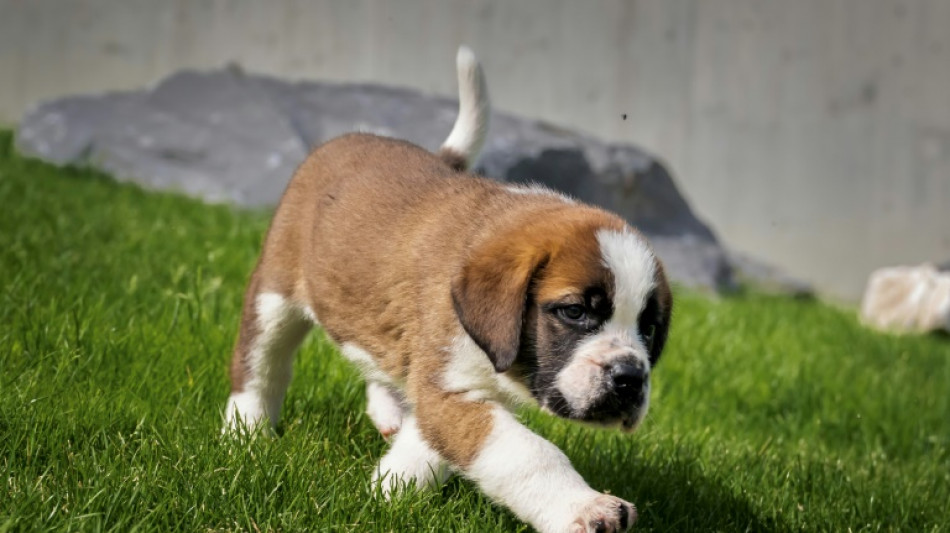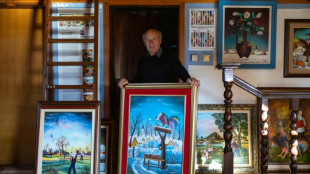

St. Bernards romp at unique Swiss theme park
Syrah walks slowly and deliberately on a treadmill submerged in a large water tank, as two therapists help keep her steady, and a crowd looks on in awe.
The eight-year-old St. Bernard is receiving her regular hydrotherapy session, while visitors to the newly reopened Barryland theme park in the Swiss Alpine valley town of Martigny follow every move.
"We give hydrotherapy to older dogs or dogs that have undergone surgery," Barryland director Melanie Glassey-Roth told AFP.
"Everything here is conceived for the wellbeing of our dogs."
Revamped from a smaller, "living museum" focused on St. Bernards, after two years of work Barryland has morphed into a large, interactive theme park fully dedicated to Switzerland's national dog.
Built in the shape of a paw print, the main building offers interactive experiences and virtual reality tours of the history and myths surround the St. Bernard, as well as the chance to interact with the big dogs themselves.
The park is hoping to see its visitor numbers soar to potentially 200,000 a year, up from 83,000 before the renovation.
- 'Emblematic' -
The St. Bernard breed, which reached a new level of stardom when it figured in the 1992 blockbuster Hollywood comedy film "Beethoven", was cross-bred into existence centuries ago in the Swiss Alps, not too far from where today's theme park lies.
It was originally bred from farm dogs indigenous to the region by a hospice monastery, perched 2,500 metres (8,200 feet) above sea level, to use for rescue work in the perilous Great St. Bernard Pass between Switzerland and Italy.
"This is an emblematic dog that represents the entire region," said Jean-Maurice Tornay, head of the Barry Foundation, which runs Barryland.
Barryland got its name from the most famous and heroic St. Bernard of all.
Local lore holds that Barry, who lived from 1800 to 1814 and was credited with more than 40 rescues in his lifetime, carried a little barrel of alcohol around his collar, a welcome drink for weary travellers.
In his honour, the monastery always had one dog named Barry -- a tradition that continues at Barryland today.
The park's current Barry, a towering 7.5-year-old male weighing around 80 kilograms (176 pounds), is the largest and most decorated of its dogs.
The Barry Foundation has 36 St. Bernards in all who live at a nearby kennel in Martigny.
Some dogs spend whole summers up at the Great St. Bernard Pass.
But with the reopening of Barryland, 16 dogs from the Martigny kennel will crowd into a large van each morning and be driven across to the theme park, ready to play stars.
- New mission -
At Barryland, the giant dogs, with their dark-ringed eyes and fur covered in reddish-brown patches, run around in spacious, grassy parks, lounge in large indoor enclosures and submit to grooming, massages and treatments.
For Thursday's reopening, the park presented two new puppies, Xcell and Xaver, who tumbled enthusiastically around their mother Lio, nudging her until she sat down to let them nurse.
Nearby, dog handler Sahel Robette encouraged Tosca, an eight-year-old female, to climb onto a large weighing scale.
"Sixty-five kilos (143 pounds)!" he exclaimed, as he began brushing her down, searching her fur for tics and inspecting her ears and nails.
Once the heroes of the Swiss Alps, St. Bernards today are doing heroic work in other settings, Tornay said.
With helicopters having taken over their rescue role, the St. Bernard has "found a new social mission", he told AFP.
The foundation's dogs make hundreds of visits each year to hospitals, nursing homes and prisons, where they are used for therapy and social training, "sharing a little bit of kindness", he said.
The St. Bernard is perfect for these missions, Glassey-Roth said, as one of the dogs laid its giant head on her lap.
"It has a quiet force; it is calm and very social."
C.Chaudhary--MT




